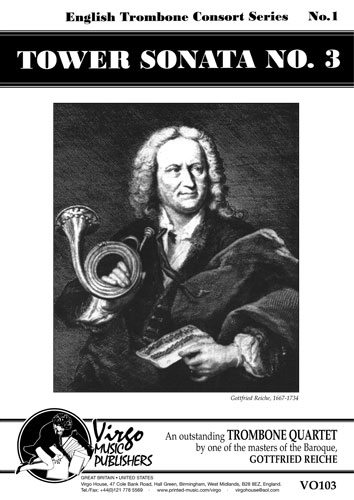Gottfried Reiche
 Tower Sonata No.3:
Tower Sonata No.3:
Arranged by English Trombone Consort
Birmingham, , United Kingdom
Publisher: Virgo Music Publishers
Date of Publication: 2016
URL: http://www.virgomusicpublishers.com
Primary Genre: Trombone Ensembles - 4 trombones
 Tower Sonata No.3:
Tower Sonata No.3: Arranged by English Trombone Consort
Birmingham, , United Kingdom
Publisher: Virgo Music Publishers
Date of Publication: 2016
URL: http://www.virgomusicpublishers.com
Primary Genre: Trombone Ensembles - 4 trombones
Gottfried Reiche (1667-1734) is probably best known today as J.S. Bach’s trumpet player in Leipzig. But his principal occupation was with the Leipzig Staadtfeifer with which he apprenticed in 1700, attained the rank of Staadtfeifer in 1706 and came to lead in 1719. We know Reiche was a virtuoso trumpeter but as leader of the Staadtfeifer, the highest musical office of the city, he was also likely quite skilled with slide trumpet, horn, trombone and cornetto. The Staadtfeifer was responsible to play the daily Abblasen from the top of town halls or towers. He composed music specifically for this purpose, which we typically refer to today as ‘tower music.’ Tower Sonata No.3 is just such a composition. It is taken from the collection he published in 1696, Vier und zwanzig neue Quatricinia, 24 short sonatas and fugues. We should pay attention to this music. It represents some of the earliest wind compositions we have and it was lost for decades after World War II, only rediscovered in the 1970’s and brought to light by the eminent musicologists, Christoph Wolff and Wolfram Steude. These are little musical gems because of their somewhat complex form and refined style. Reiche’s title for this piece as published in the Quatricinia is 3. Sonatina. It consists of a slow, seven measure, homophonic prelude followed by a brisk fugue and short coda, a little over two minutes long depending on tempo. Reiche specifically designates its four parts to be played by cornett, alto trombone, tenor trombone and bass trombone. It is set in 3/2 meter and tonally centers on A (A minor) with a range spanning D to b-flat3. The Virgo score designates its parts as Trombone 1-4, using alto and tenor clefs for the top two parts and bass clef for the bottom two parts. Its credits read, ‘Transcribed and edited by the English Trombone Consort,’ but it actually goes a bit beyond transcription into the realm of arrangement. As can be seen from the range span above, merely lowering the piece by any large interval would not yield a comfortably playable trombone quartet. To place their trombone version of this work in a good place, the Consort changed the meter to 3/4, thereby doubling the number of measures. They raised its tonal center to C, placing three flats in the key signature. This necessitates changes to the voices themselves. There are many octave displacements in the bass voice that are simply designed to make the line more playable in this key. Middle voices are sometimes exchanged with one another for brief moments. The top voice is unchanged with the exception of one measure where four notes are transposed a third higher. This deviates from Reiche’s score but yields a smoother line. Several accidentals in the piece also deviate from Reiche’s score. It’s not clear whether these represent corrections to perceived errors in the original publication or whether the Consort simply preferred the sound of these alterations. In any case, they are relatively minor, with the exception of one, which represents a fundamental recasting of Reiche’s prelude idea. The prelude contains just three phrases, forte, piano, forte, the last phrase being a short but dramatic full cadence with raised third... a big, forte, major conclusion. The Consort recasts the prelude to mezzo forte, piano, mezzo forte, and lowers the third of its final cadence, rendering a softer, more demur, minor conclusion. This alteration clearly seems aimed at creating contrast with the coda, which ends with Reiche’s exact same forte, major cadence from the prelude. Having duly noted all the deviations above, Tower Sonata No.3 is as pleasing to hear as it is a pleasure to play. Each part lies wonderfully on the instruments and fit together beautifully, range C-dflat2. It seems to have been arranged as a playable, accessible piece that any moderate to advanced trombone quartet can learn and perform quickly, which seems right in line with Virgo’s perceived publishing mission. If you want an urtext level/type transcription of this piece, this is not it. If you want your trombone quartet to play this music successfully right away, this arrangement will not disappoint. To play this music from the roof of a building in a modern city would likely be an exercise in futility today. But it is thrilling to imagine how much this music enriched the 18th century lives of Leipzig’s ordinary citizens when it sounded from their tower. Reiche’s music would have exploded into their workaday lives for a brief few minutes each day, which was mostly devoid of fine music by comparison to our media swamped culture. Trombones were a major part of that sound. Reiche’s music is an important part of our roots that we should continue to share today. Tower Sonata No.3 is an expedient path to that goal. -Mike Hall Old Dominion University
Reviewer: Review Author
Review Published July 10, 2023
Review Published July 10, 2023